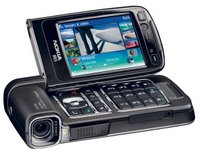 One of the most anticipated models of the Nokia N series is the Nokia N93, and it's easy to see why. This high-end "multimedia computer" (as Nokia likes to call it) boasts a 3.2-megapixel camera with Carl Zeiss optics, and it can record MPEG-4 VGA video at up to 30 frames per second. It has a dual-hinge swivel design, TV-out capabilities, and photo and video editors. In addition, the Symbian OS-based phone is equipped with Bluetooth, Wi-Fi, and e-mail support. A big set of features for a big phone--no really, this mobile is huge. Aesthetics aside, the N93 performs most of its functions well, but it's not for everyone. The powerful smart phone is best suited for those who love all-in-one devices and crave the latest and greatest tech. As of this writing, no U.S. carrier has picked up the phone, which unfortunately means you'll have plunk down some serious cash ($700 to $800) for this baby.
One of the most anticipated models of the Nokia N series is the Nokia N93, and it's easy to see why. This high-end "multimedia computer" (as Nokia likes to call it) boasts a 3.2-megapixel camera with Carl Zeiss optics, and it can record MPEG-4 VGA video at up to 30 frames per second. It has a dual-hinge swivel design, TV-out capabilities, and photo and video editors. In addition, the Symbian OS-based phone is equipped with Bluetooth, Wi-Fi, and e-mail support. A big set of features for a big phone--no really, this mobile is huge. Aesthetics aside, the N93 performs most of its functions well, but it's not for everyone. The powerful smart phone is best suited for those who love all-in-one devices and crave the latest and greatest tech. As of this writing, no U.S. carrier has picked up the phone, which unfortunately means you'll have plunk down some serious cash ($700 to $800) for this baby.Design of Nokia N93
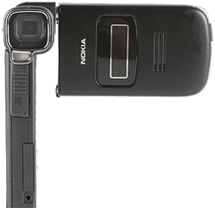 To put it bluntly, the Nokia N93 is a beast. The unit measures 4.6 by 2.1 by 1.1 inches and weighs 6.3 ounces, which is mammoth for a cell phone, especially when you open the flip phone to make or accept a call. In its open state, the N93 is about 7.5 inches long and is actually longer than our cordless phone at home. It's certainly a dramatic change from the skinny and compact phones that dominate the market today; as such, the N93 will take some getting used to as a mobile phone because of its large size. We also found that the middle section of the phone, where the camera lens is housed, juts out a bit, hitting our cheek and making for a somewhat uncomfortable experience.
To put it bluntly, the Nokia N93 is a beast. The unit measures 4.6 by 2.1 by 1.1 inches and weighs 6.3 ounces, which is mammoth for a cell phone, especially when you open the flip phone to make or accept a call. In its open state, the N93 is about 7.5 inches long and is actually longer than our cordless phone at home. It's certainly a dramatic change from the skinny and compact phones that dominate the market today; as such, the N93 will take some getting used to as a mobile phone because of its large size. We also found that the middle section of the phone, where the camera lens is housed, juts out a bit, hitting our cheek and making for a somewhat uncomfortable experience.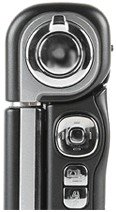 To be completely fair, the N93 is more than just a phone, and when used as a camcorder, the N93's size becomes more of a pro than a con. It's easy to travel with and includes a number of design features that mimic the look and feel of a real mini camcorder. First, you can manipulate the screen to act as your viewfinder. Just open the front flap halfway and swivel the screen 90 degrees counterclockwise. This will automatically activate the camera, and you should see the scene of your photo or video splashed across the internal screen/viewfinder. The camera lens and flash are located on the left spine; the former is protected by a plastic cover, but it's not attached to the phone, so take care not to lose it (a lens strap is included in the box). In addition to this lens, there's a secondary VGA camera above the internal screen that you can use for photos and video. On the right side is a zoom in/out slider wheel and a center capture button on the hinge of the phone, while a four-way navigation toggle, a camera/video button (to toggle between the two modes), and a flash key are on the right spine. Overall, most of these buttons are easy to master and use as camcorder controls, although we had a couple of complaints. First, the toggle may be too small for some users, especially those with larger fingers, causing you to accidentally press the keys beneath it. Second, the zoom slider is somewhat difficult to use one-handed; we found it easiest to move by using our index finger instead of our thumb.
To be completely fair, the N93 is more than just a phone, and when used as a camcorder, the N93's size becomes more of a pro than a con. It's easy to travel with and includes a number of design features that mimic the look and feel of a real mini camcorder. First, you can manipulate the screen to act as your viewfinder. Just open the front flap halfway and swivel the screen 90 degrees counterclockwise. This will automatically activate the camera, and you should see the scene of your photo or video splashed across the internal screen/viewfinder. The camera lens and flash are located on the left spine; the former is protected by a plastic cover, but it's not attached to the phone, so take care not to lose it (a lens strap is included in the box). In addition to this lens, there's a secondary VGA camera above the internal screen that you can use for photos and video. On the right side is a zoom in/out slider wheel and a center capture button on the hinge of the phone, while a four-way navigation toggle, a camera/video button (to toggle between the two modes), and a flash key are on the right spine. Overall, most of these buttons are easy to master and use as camcorder controls, although we had a couple of complaints. First, the toggle may be too small for some users, especially those with larger fingers, causing you to accidentally press the keys beneath it. Second, the zoom slider is somewhat difficult to use one-handed; we found it easiest to move by using our index finger instead of our thumb.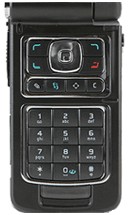 After you've captured images, you can take advantage of the N93's swivel design to best view your photo gallery and videos. To do so, start with the phone in its closed state and swing open the front flap to the right (Nokia identifies this as the View mode). From there, you can see all your shots on the N93's sharp, 2.4-inch QVGA internal screen. It displays an eye-popping 262,144 colors at a crisp 320x240-pixel resolution, so not only do images look great, so do text and Web pages. You can change the theme, wallpaper, and backlight time, but you can't change the font size. Below the display is a set of buttons, including two soft keys; the talk and end buttons; a four-way navigation control; a row of shortcut keys to the text editor, main menu, multimedia menu; and a clear button. The numerical dial pad below these controls is spacious and raised above the phone's surface, making it easy to dial by feel.
After you've captured images, you can take advantage of the N93's swivel design to best view your photo gallery and videos. To do so, start with the phone in its closed state and swing open the front flap to the right (Nokia identifies this as the View mode). From there, you can see all your shots on the N93's sharp, 2.4-inch QVGA internal screen. It displays an eye-popping 262,144 colors at a crisp 320x240-pixel resolution, so not only do images look great, so do text and Web pages. You can change the theme, wallpaper, and backlight time, but you can't change the font size. Below the display is a set of buttons, including two soft keys; the talk and end buttons; a four-way navigation control; a row of shortcut keys to the text editor, main menu, multimedia menu; and a clear button. The numerical dial pad below these controls is spacious and raised above the phone's surface, making it easy to dial by feel.Other design highlights of the N93 include a 1.1-inch external LCD that shows 65,536 colors at a 128x36-pixel resolution. It displays the standard information, including the time, network strength, battery life, and photo caller ID (where available). Also, if you're using the N93 as a music player, the screen will show you the song title and track time. While this is a nice extra, we were a bit disappointed by the screen's small size, considering that there's plenty of real estate to put in a larger display. In addition to the camera lens and flash, there is a Mini SD expansion slot, a Pop-Port connector (for the USB cable and headset), and a charger connector on the left; the power on/off button is on the top of the device. We wish Nokia had included external volume controls. Instead, you have to remove the phone from your ear and use the navigation toggle on the dial pad to adjust the volume.
Nokia packages the N93 with a nice set of accessories, including an AC adapter, a travel charger, a 128MB Mini SD card, a pair of stereo earbuds, a USB cable, video cables, a protective pouch, a wrist strap, reference material, and a DVD containing the Nokia PC Suite, photo editors, and more.
Features of Nokia N93
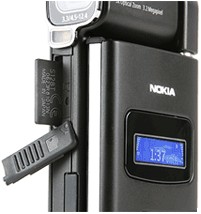 The Nokia N93 has a sizable feature set to match its large form factor. The main attraction, of course, are the camera and camcorder functions. The N93 is equipped with a 3.2-megapixel camera with a Carl Zeiss Vario-Tessar lens and 3X optical zoom. (For those of you who don't know, Carl Zeiss was an optician who first started manufacturing lenses for microscopes, then used his expertise for camera lenses.) The camera options are very similar to those of the other N-series models we've reviewed, including the Nokia N80 and the N73. You get a choice of four image qualities (large, medium, small, and multimedia message) and six shooting modes (automatic, user, close-up, landscape, night, and night portrait). Plus, there are white balance options, exposure values, and color tones so that you can get the best picture possible. There's also a sequence mode for multiple shots and a self-timer. You get four shutter sound options, but no silent mode.
The Nokia N93 has a sizable feature set to match its large form factor. The main attraction, of course, are the camera and camcorder functions. The N93 is equipped with a 3.2-megapixel camera with a Carl Zeiss Vario-Tessar lens and 3X optical zoom. (For those of you who don't know, Carl Zeiss was an optician who first started manufacturing lenses for microscopes, then used his expertise for camera lenses.) The camera options are very similar to those of the other N-series models we've reviewed, including the Nokia N80 and the N73. You get a choice of four image qualities (large, medium, small, and multimedia message) and six shooting modes (automatic, user, close-up, landscape, night, and night portrait). Plus, there are white balance options, exposure values, and color tones so that you can get the best picture possible. There's also a sequence mode for multiple shots and a self-timer. You get four shutter sound options, but no silent mode.For video, the N93 can record up to one-hour clips with sound at up to 30 frames per second (fps). Options are a little more limited in video mode; you get five quality settings (TV high, TV normal, handset high, handset normal, and sharing) and two shooting modes (automatic and night). You also have access to 3X optical zoom or 8X digital zoom, and there's a video stabilization feature to help reduce camera shake as you're recording video. You can touch up your videos and photos with the included image editors. For example, you can add clip art and reduce red-eye on still images, or cut audio for videos. There's 50MB of internal memory, backed by the Mini SD expandable memory, for saving your photos and videos to the phone. And sharing your memories is also easy with the ability to view them as a slide show, print them using Nokia's Xpress Solutions, upload them to the Web, or transfer them to other devices. Also, Nokia includes video-out cables so that you can hook up your N93 to a TV to view all your media on the big screen.
Overall, the Nokia N93 takes good quality pictures. Colors are vibrant and lines sharp; videos are also pretty decent. The N93 certainly won't replace your stand-alone digital camera or camcorder, but it's a good stand-in when you're in a pinch, and it's certainly one of the better camera phones we've seen to date.
As a multimedia computer, the Nokia N93 isn't limited to just imaging and video. There's also an integrated music player that supports MP3, WMA, AAC, AAC+, and eAAC+ files, as well as OMA DRM 2.0- and Janus DRM-protected songs. The music library categorizes tracks by artist, album, genre, and composer; you can also create playlists right on the phone and adjust the sound with the built-in equalizer. To transfer music onto the device, simply plug in the included USB cable and use the N93 as a removable drive. Craving new music or some diversity? Check out the N93's FM radio, though you'll have to use the included headset to access the radio, since it acts as the tuner. RealPlayer is also onboard, with 3GPP and MPEG-4 video-streaming support.
The Nokia N93 is well connected in other respects. First, as a phone, you get a speakerphone, speed dial, conference calling, video calls, voice command support, a vibrate mode, and text and multimedia messaging. As with the Treo 700 series, you can ignore a call with a text message. The N93's address book is limited only by the available memory, and the SIM card holds an additional 250 contacts. There's room in each entry for multiple phone numbers, work and home addresses, e-mail addresses, a birthday, and more vitals. For caller ID purposes, you can assign each contact a photo, one of 41 ring tones, or a group ID.
Other than cellular wireless, the Nokia N93 has integrated Bluetooth, Wi-Fi, and an infrared port. Bluetooth is version 2.0 with support for a number of profiles, including Basic Printing, Dial-up Networking, Headset, Handsfree, Generic Object Exchange, File Transfer, and Basic Imaging. There is, however, no support for the A2DP profile for stereo headsets. As far as Wi-Fi goes, the N93 is compatible with 802.11b/g standards; in addition, there's support for Universal Plug and Play (UPnP), which lets you use a Wi-Fi connection to hook up with a compatible PC, printer, or home entertainment system. The downside is that the number of UPnP devices is limited at the moment.
The Nokia N93 runs Symbian OS 9.1, so you get basic PIM capabilities and more. There's a calendar, a to-do list, notes, a calculator, a voice recorder, a currency converter, and an HTML/XHTML Web browser. An app called QuickOffice lets you view (but not edit) Microsoft Word, Excel, and PowerPoint files; plus, Adobe Reader is onboard for PDFs. The N93 is also equipped with e-mail capabilities. The phone supports SMTP, IMAP4, and POP3 accounts with full attachment viewing and mobile VPN support for corporate users. Finally, the Nokia PC Suite helps you synchronize the N93 with your PC to manage appointments, music, device memory, and more.
Performance of Nokia N93
We tested the triband (GSM 900/1800/1900; EDGE) Nokia N93 in San Francisco using Cingular's service, and call quality was a mixed bag. On our end, callers sounded fine but reported some distortion on their end and said we sounded like we had a cold. Unfortunately, activating the speakerphone didn't help matters as it added an echo to the mix. On the upside, we had no problems pairing the N93 with the Logitech Mobile Traveller Bluetooth headset.
The N93 performed its other duties admirably. Music playback was respectable, although listening to tracks through the built-in speakers on front of the device sounded a bit blown out. Plugging in the included earbuds helped. Watching videos on the handset was also OK. We had no problem making out the picture, but there was some pixelation and blurriness, a plague of all cell phones with multimedia capabilities. Browsing the Web on the N93 was great, as pages loaded quickly, and we didn't experience any great delays when switching between apps, as has been the case with other N-series devices.
The Nokia N93 is rated for 5.1 hours of talk time and up to 10 days of standby time. In our tests, the N93 met the rated time and surpassed it by an hour.

 Add to Favorites
Add to Favorites
0 comments: